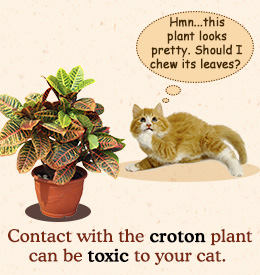Fancying getting a croton houseplant? Think before you leap. If you have a cat at home who loves venturing and exploring new things, you need to be careful. This article tells whether the croton plant is cat-friendly or not, and how toxic it is for them.

If you love indoor plants, why not make it pet-friendly? Instead of taking the risk of letting your cat nibble on toxic plants, consider buying cat-friendly plants such as catnip, catmint, basil, etc.Cats! They love to nibble, out of curiosity, everything that comes their way, and your houseplants are no exception. They love to chew on leaves, and chances are your houseplants are the next victims. If not, they simply love to sit near windows and observe. Of course, there is the possibility that you might have decorated your window with these houseplants. However, if you're planning to bring home a pretty houseplant, think twice. Can it be toxic to your cat? There are a host of houseplants that are toxic for cats. One of them is the croton plant. Also known as the rushfoil plant, it belongs to the genus Euphorbiaceae.
So, your furry friend is not safe around a croton plant. It is toxic for your cat, and can lead to many disorders. It is also mildly toxic for humans, and can be dangerous for kids too.
Symptoms of Croton Plant PoisoningFirst and foremost, you should keep a keen eye on your cat. Look out if it is appearing lethargic, or vomits too frequently. Do not take it lightly, when you know there's a plant around your house that can harm your pet.
Symptoms in case of ingestion:
► Vomiting
► Diarrhea
► Burning sensation
► Throat irritation
► Gastrointestinal disorder
►
Contact with the plant can lead to skin irritation, dermatitis, and blistering.
► This can become serious, since an overdose of this plant can lead to a coma, and the eventual death of the cat too.
Treatment Options► Consult your vet immediately, and call for medical attention. Do not try any home remedies or try to induce vomiting on your own accord, unless directed by the vet.
► Try to isolate the cat from other pets, and soothe it.
► Seek help from a helpline. There are some paid helpline centers, such as ASPCA (American Society for the Prevention of Cruelty to Animals), that might guide you through the process.
Preventive MeasuresIf possible, the best measure is not to bring this plant at home at all. However, if you're in awe with it, you can take the following precautionary measures.
► Make sure that the plant is kept at a place that is not frequented by your cat.
► If possible, supervise your cat. However, this is extremely difficult, given the curious nature of cats, and you cannot follow it everywhere. They can sneak out in no time, and end up in a disaster.
► Keep the vets number handy, and make sure you have easy access to him in case of any untoward incident.
► Opt for pet-friendly plants. Consult your vet, and visit your nursery.
► Keep your pet busy with toys, scratch posts, etc., so that there are less chances of it venturing near your croton. You certainly don't want a disaster, simply because your cat found the leaves too attractive. Most importantly, feed your cat at regular intervals, so that it does find the necessity to chew unnecessary stuff. Yet, cats are cats, and you never know what their curiosity might lead into. Hence, it is best to keep them away from such plants.
In short, the combo of a croton plant and a cat is a strict no-no! Protect your cat from being a victim to this attractive, yet deadly ornamental plant!
Disclaimer: This article is for informative purposes, and should not be taken as a substitute for medical opinion. Consult your vet in case of any emergencies.






 If you love indoor plants, why not make it pet-friendly? Instead of taking the risk of letting your cat nibble on toxic plants, consider buying cat-friendly plants such as catnip, catmint, basil, etc.Cats! They love to nibble, out of curiosity, everything that comes their way, and your houseplants are no exception. They love to chew on leaves, and chances are your houseplants are the next victims. If not, they simply love to sit near windows and observe. Of course, there is the possibility that you might have decorated your window with these houseplants. However, if you're planning to bring home a pretty houseplant, think twice. Can it be toxic to your cat? There are a host of houseplants that are toxic for cats. One of them is the croton plant. Also known as the rushfoil plant, it belongs to the genus Euphorbiaceae.
If you love indoor plants, why not make it pet-friendly? Instead of taking the risk of letting your cat nibble on toxic plants, consider buying cat-friendly plants such as catnip, catmint, basil, etc.Cats! They love to nibble, out of curiosity, everything that comes their way, and your houseplants are no exception. They love to chew on leaves, and chances are your houseplants are the next victims. If not, they simply love to sit near windows and observe. Of course, there is the possibility that you might have decorated your window with these houseplants. However, if you're planning to bring home a pretty houseplant, think twice. Can it be toxic to your cat? There are a host of houseplants that are toxic for cats. One of them is the croton plant. Also known as the rushfoil plant, it belongs to the genus Euphorbiaceae.